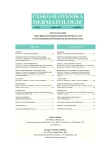Contact Hypersensitivity to Cosmetic and Pharmaceutical Additives in Patients with Eczema
Authors:
E. Dastychová; M. Nečas
Authors‘ workplace:
I. dermatovenerologická klinika LF MU a FN U sv. Anny v Brně
přednosta doc. MUDr. Vladimír Vašků, CSc.
Published in:
Čes-slov Derm, 85, 2010, No. 2, p. 78-90
Category:
Clinical and laboratory Research
Overview
Additives in topical dermatologics and cosmetics might act as hidden allergens, especially, in patient with chronic eczema. They include preservatives, emulgators and antioxidants. Out of the group of 2 400 patients with chronic eczema (1 655 females and 745 males, mean age 44,4 years), examined during years 2001–2009, in 953 patients atopic eczema was the main diagnosis. Patch tests included 27 additives including five of the European Standard Series (parabens-mix, lanolin alcohol, kathon CG, quaternium-15, formaldehyde). Contact sensitization to at least one allergen was found in 751 patients (31%). The most frequent allergen was lanolin alcohol (3,3% of patients), bronopol (1,7%), dibromdicyanobutane/phenoxyethanol (1,5%), kathon CG (1,4%), chloracetamide (1,3%), chlorhexidine digluconate and benzalkonium chloride (1,2%), parabens (1%), diazolidinyl urea (0,9%), quaternium-15 (0,8%), imidazolidinyl urea (0,6%). Frequency of senzibilization to particular additives was compared in different localization of eczema, e.g. face and neck, hands and forearms, feet and shins and in generalized eczema. No statistically significant difference between males and females was found in frequency of senzibilization evaluated by binomial test on the 5% significance level. The senzibilization frequency in atopic patients was significantly increased in comparison to non-atopic patients.
Key words:
contact eczema – preservatives – antioxidants – emulgators
Sources
1. Boyvat, A., Akyol, A., Gürgey, E. Contact sensitivity to preservatives in Turkey. Contact Dermatitis, 2005, 52, 329-332.
2. Goossens, A., Cleas, L., Drieghe, J., Put, E. Antimicrobials: preservatives, antiseptics and disinfectants. Contact Dermatitis, 1997, 39, 133.
3. Hasan, T., Rantanen, T., Alanko, K., Harvima, RJ., Jolanki, R., Kalimo, K., Lahti, A., Lammintausta, K., Lauerma, AI., Laukkanen, A., Luukkaala, T., Riekki, R., Turianmaa, K., Varjonen, E, Vuorela, A.-M. Patch test reactions to cosmetic allergens in 1995-1997 and 2002-2002 in Finland – a multicentre study. Contact Dermatitis, 2005, 53, 40-45.
4. Jong, CT., Statham, BN., Green, CM., King, CM., Gawkrodger, DJ., Sansom, JE., English, JS., Wilkinson, SM. Ormerod, AD., Chowdhury, MM. Contact sensitivity to preservatives in the UK, 2004-2205: results of multicentre study. Contact Dermatitis, 2007 Sep, 57 (3), 165-168.
5. Kieć-Swierczyńska, M., Krecisz, B., Swierczyńska-Machura, D. Contact allergy to preservatives contained in cosmetics. Med Pr., 2006, 57 (3), 245-249.
6. Noiesen, E., Munk, MD., Larsen, K., Johansen, JD., Agner, T. Difficulties in avoiding exposure to allergens in cosmetics. Contact Dermatitis, 2007, 57, 105-109.
7. Ritschel, RL., Fowler, JF. jr. Fisher’s Contact Dermatitis. Philadelphia, USA, Lippincott Williams-Wilkins (fifth Edition), 2001, 212-214, 223-225, 228-229, 236.
8. Uter, W., Balzer, Ch., Geier, J., Frosch, PJ., Schnuch, A. Patch testing with patients’ own cosmetics and toiletries – results of the IVDK, 1988-2002. Contact Dermatitis, 2005, 53, 226-233.
9. Wilkinson, JD., Shaw, S., Andersen, KE., Brandao, FM., Bruynzeel, DP., Bruze, M., Camarasa, JM., Diepgen, TL., Ducombs, G., Frosch, PJ., Goossens, A., Lachappelle, JM., Lahti, A., Menné, T., Seidenari, S., Tosti, A., Wahlberg, JE. Monitoring levels of preservative sensitivity in Europe. A 10-year overview (1991-2000). Contact Dermatitis, 2002 Apr, 46 (4), 207-210.
10. Zoller, L., Bergman, R., Weltfriend, S. Preservatives sensitivity in Israel: a 10-year overview (1995-2004). Contact Dermatitis, 2006 Oct, 55 (4), 227-229.
Labels
Dermatology & STDs Paediatric dermatology & STDsArticle was published in
Czech-Slovak Dermatology

2010 Issue 2
Most read in this issue
- A Case Study of a Female with Atypical Localization of Syphilitic Chancre
- Skin Reactions to New Agents (Biologicals and Targeted Anticancer Drugs)
- Rosacea Fulminans
- Skin Side Effects of Epidermal Growth Factor Receptor Inhibitors in Oncologic Therapy
